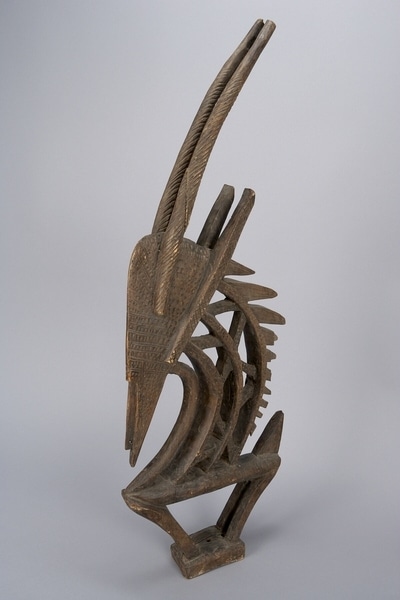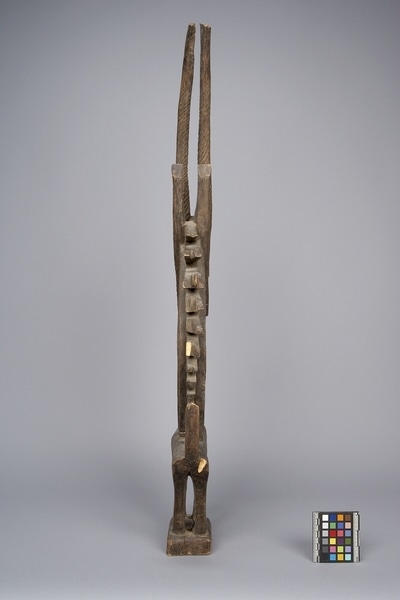Headdress Item Number: 790/3 from the MOA: University of British Columbia




Description
Antelope headdress. Elongated face with two horns that are covered with elaborate designs, spirals, diamond shaped carvings. Carved out of one piece of wood. The large curved neck has a cross hatched design and mane. Body has an upright tail and four legs attached to a base with three holes on the underside.
History Of Use
Chi Wara (or Tyi Wara, etc.) headdresses are made to be danced as a pair (male and female) at harvest festivals to honour Chi Wara, a half human half antelope mythical being who taught agriculture to the ancestors of the Bamana people. The headdresses embody the ingredients necessary for successful cultivation, their long horns representing the tall growth of millet. The headdress is attached to a wicker cap, which is strapped around the chin of a dancer.
Specific Techniques
The wood is oiled and then charred in fire to deepen the colour.
Iconographic Meaning
The headdresses are inspired by antelopes, armoured pangolins, and aardvarks. The antelope head represents the strength and grace needed to farm. The armoured pangolin's body represents protection, and the aardvark's legs represent good digging needed for farming. The male Chi Wara headdress represents the sun, while the female one represents the earth. The long horns represent the tall growth of millet. The fibre ties of the wicker cap, that the headdress would have been attached to, are associated with streams of water.
Item History
- Made in Burkina Faso ?
- Owned by W. H. L. Allsopp before April 26, 1982
- Received from W. H. L. Allsopp (Seller) and Museum of Anthropology Shop Volunteers (Funding source) on April 26, 1982
What
Who
- Culture
- Bamana
- Previous Owner
- W. H. L. Allsopp
- Received from
- W. H. L. Allsopp (Seller) and Museum of Anthropology Shop Volunteers (Funding source)
Where
- Holding Institution
- MOA: University of British Columbia
- Made in
- Burkina Faso ?
When
- Ownership Date
- before April 26, 1982
- Acquisition Date
- on April 26, 1982
Other
- Condition
- fair
- Accession Number
- 0790/0003